Abstract
This article deals with the study of the initial water saturation effect of a porous medium on the oil recovery factor using a water-based nanosuspension. The initial water saturation of the porous medium in the computations varied within the range from 0 to 90%. The nanoparticle SiO2 concentration varied from 0 to 1 wt%. The particle sizes were equal to 5, 18, 22, and 50 nm. Experimentally measured wetting angles and the interfacial tension coefficient depending on the concentration and size of nanoparticles were used in computations. A mathematical model was developed, describing the transfer and diffusion of nanoparticles within the aqueous phase during immiscible displacement of oil by nanosuspension from a porous medium. Using the developed model, a systematic computational study of the effect of the initial water saturation of the core micromodel on the oil recovery factor using nanosuspension was carried out. It was revealed that with an increase in the initial water saturation, the oil recovery factor monotonically decreased in the case of displacement both by water and nanosuspension. It was shown that with an increase in the concentration of nanoparticles and a decrease in their size, the oil recovery factor increased. At that, the relative increase in the recovery factor had a maximum at an initial water saturation equal to 60%.
Keywords:
oil recovery; oil recovery factor; nanofluids; particle size; water saturation; VOF method 1. Introduction
It is known that in recent decades, the level of oil production at large fields in the world, which accounts for more than 60% of reserves, has been falling. The main problem is related to the deterioration of the resource potential of these deposits, most of which have been in operation for more than 30 years. The level of water cut at large deposits that have been put into development for a long time today reaches 70–80%. The current trend is that if nothing is done, oil production will continue to decline, and the commissioning of new smaller deposits will not compensate for this decline. The current situation requires creating new highly efficient methods and technologies for developing hydrocarbon deposits that make production profitable in the context of low oil prices.
Various methods are used to enhance oil recovery: oil displacement by water, polymer flooding, injecting carbon dioxide, in situ combustion, and others [1,2,3]. One of the promising methods of this kind is nanoemulsions (nanofluids), widely used for the development and operation of oil and gas wells [4,5,6,7,8]. Nanofluid is a suspension with nanoparticles whose dimensions do not exceed, as a rule, 100 nm. The study of the properties of nanofluids in various applications has become one of the research trends of the last decade. From the perspective of possible applications of nanofluids in oil production, the viscosity, the wetting angle, and the interfacial tension coefficient of the flooding agent play a key role. Here, nanofluid is a unique material since its above-mentioned properties significantly depend on the concentration, size, material, and morphology of nanoparticles. By varying these properties, it is possible to obtain a real tool for controlling the oil displacement process from the reservoir. In particular, this is evidenced by the works that have appeared in recent years, which indicate that using nanofluids can significantly enhance the oil extraction volumes from the reservoir [4,5,6,7,8]. Below are just a few concrete examples.
Chandio et al. [9] have shown that using nanofluid makes it possible to increase the oil recovery factor (ORF). Based on promising laboratory results, from an economic and environmental standpoint, silica is an ideal material for future applications among all nanomaterials due to its properties. Conducted experiments have shown that the concentration of SiO2 particles of 0.05 wt% is optimal and provides an oil recovery enhancement of 15% compared to displacement by water. At that, a further increase in concentration leads to a decrease in oil recovery. This phenomenon is explained in the work by the clogging of pores and the emergence of particle agglomerates. The paper [10] states that the addition of silicon nanoparticles to the displacing fluid with a concentration of 0.2 wt% + SDS can increase the ORF on average from 4 to 14% on a sandy rock sample. At the same time, the authors of [11] revealed that the ORF improved with an increase in the concentration of SiO2 particles until the optimal concentration was reached. The maximum oil recovery was achieved at a nanoparticle concentration of 0.1 wt%. The final production of the original oil at the field has increased by 13.28%.
A significant part of the research on using nanosuspensions to enhance the ORF when injected into the reservoir is associated with numerical simulations [12,13,14,15,16,17].
One of the first approaches to nanosuspension flow simulation was developed by Ju et al. [12,13]. The authors have developed a one-dimensional model of nanofluid flow in a porous medium taking into account the pore colmatation. The simulation results using a 1D model coincided well with the experimental data. It was revealed that the greatest effect of oil recovery enhancing was achieved at a particle concentration of about 3 vol%.
Yin Feng et al. [12] conducted numerical studies on the effect of parameters, such as the duration and injection volume of nanosuspension on the efficiency of oil recovery. At that, the employed mathematical model took into account the adsorption of nanoparticles but did not account for capillary pressure and change in wettability. Various injection scenarios of nanosuspensions were simulated, namely continuous injection, injection of the oil fringe, and subsequent flushing. Additionally, the effect of injection time, injection rate, and the size of the oil fringe on oil recovery were also studied. The results have shown that when flooding with nanofluids is used after conventional flooding with water as a method of tertiary extraction, early injection of nanofluids improves oil recovery, but leads to large consumption of nanosuspension. A higher injection rate of nanofluids can contribute to increasing the flooding efficiency, but not increasing the resulting oil recovery, and also cause large losses of nanoparticles. Compared with continuous injection, injection to the oil fringe with subsequent washing allows saving the volume of suspension consumed.
A computational study of the effect of the added nanoparticles on the wettability of walls and pore calcification was carried out by Sepehri et al. using the Darcy model [15]. It has been shown that an increase in the nanofluid concentration and volume can lead to deterioration in the porosity and permeability of the rock, especially in the inlet area.
The article [16] presents the results of a computational study of the effect of salinity on the efficiency of oil recovery by a nanofluid. At that, unlike other approaches, the nanoparticle transfer equation in this work was solved analytically. The results have shown that the presence of high ionic strength (1 wt% or 0.13 M KCl) and multivalent ions (Ca~, Mg) significantly affects the breakthrough of carbon nanoparticles through the core model at a linear pore velocity of 0.67 cm/min. This is probably due to the charge interaction between the carbon nanoparticles in the suspension and the interaction of carbon nanoparticles with a porous medium. This charge interaction has been drastically reduced by surface modification techniques.
There are very few works in which the effect of nanofluid properties on the efficiency of oil recovery is studied using numerical simulation. An example of such a study is given in the article by Gharibshahi et al. [17], in which the effect of factors, such as the type of nanoparticles, their concentration, and size, as well as the temperature of the injected fluid is studied using the volume of fluid (VOF) method on the oil displacement process. In the course of the study, it was shown that an increase in particle concentration results in enhanced ORF. While studying the effect of particle sizes, it was shown that a decrease in particle size enhances the ORF. The article presents also the simulation of the effect of the injected fluid temperature on the oil recovery factor. The increase in temperature caused a decrease in the viscosity of the oil and an increase in the recovery factor.
As it was shown above, laboratory experiments and numerical simulations have shown very promising results in the nanofluid-based oil displacement. At the same time, this topic turned out to be so broad that additional research is needed for its in-depth study. In particular, the issue of the effect of initial water saturation on the ORF by nanofluids has not been practically investigated at present. The point is that the injection of nanosuspensions and nanoemulsions should be attributed to the so-called tertiary methods of enhancing oil recovery. This means that before their injection, the oil reservoir has been subjected to conventional flooding for a long time, and thus has already been sufficiently watered. The goal of applying the tertiary methods is to wash out residual oil from the rock. In the above research results, it was shown that flooding of the core with nanosuspensions at zero initial water saturation allows increasing oil recovery by 10–30%. In the present work, for the first time, we proposed to answer the question of how successfully nanosuspensions will cope with an increase in oil recovery at various stages of reservoir flooding. This problem is important for practice since it allows assessing the feasibility of using an injection of nanosuspensions at various stages of field development. From a scientific viewpoint, this problem is also very interesting and differs significantly from those considered earlier. The point is that when oil is displaced by nanosuspension from a core with zero water saturation, we are dealing with the flow of two immiscible fluids (oil and nanosuspension). In case the water is present in a porous medium, the nanofluid mixes with it, thereby changing the concentration of nanoparticles. As was shown earlier, the characteristics of the nanosuspension (viscosity, wettability, and IFT) significantly depend on the concentration, which obviously affects the oil recovery efficiency. There are currently very few works that investigate the flow of two immiscible fluids with changing component concentration in one of them.
Thus, in the present article, systematic studies on the effect of the initial water saturation of the core on the oil displacement efficiency using nanosuspensions were carried out for the first time, based on numerical simulation.
2. Description of the Mathematical Model and Formulation of Simulation
A numerical study of oil displacement from a porous medium using nanosuspensions was carried out in a wide range of initial water saturation. The numerical method was based on the solution of a system of Navier–Stokes equations for a multicomponent incompressible medium. The VOF method was used to describe the immiscible oil–water flow (nanosuspension) in a porous medium [18]. This model allows simulating an immiscible multicomponent fluid–fluid flow by solving several momentum transfer equations taking into account the volume fraction of each phase.
The density and viscosity of the mixture included in the Navier–Stokes equations are determined as follows:
here and are the density and viscosity of oil, respectively, and and are the density and viscosity of nanofluids depending on the particle concentration φ.
The weight conservation equation, in this case, has the standard form:
Here, is the velocity vector of the mixture, which is determined by solving the momentum equation:
where p is the static pressure of the mixture and is the vector of the volumetric force caused by capillary forces.
To simulate the movement of the interface in the course of oil displacement, the following transfer equation is solved:
When oil is displaced from a porous medium, capillary forces are very important. To simulate surface tension, we used the continuous surface force (CSF) algorithm by Brackbill et al. [19]. In this method, the effects of surface tension are simulated by adding a source to the momentum equation:
where is IFT, k is the curvature of the interface, which is determined as:
where is the vector, normal to the interface, which is determined in the volume of the computational domain as follows:
At the walls of the computational domain, the normal vector is determined using the following expression:
here is the wetting angle at the wall, is perpendicular to the wall, and is directed tangentially to the wall vector.
In computations, we used viscosity , density , interfacial tension , and wetting angle of the nanosuspension, experimentally measured depending on the concentration φ and nanoparticle size. Experimental data can be found in our recent papers [20,21].
To simulate the nanosuspension dilution process during its flow in a porous medium, saturated with water, the equation of nanoparticle concentration transfer (only within the aqueous phase) was additionally introduced:
where φ is the weight concentration of particles, D is the diffusion coefficient of nanoparticles.
The diffusion coefficient of nanoparticles in the base fluid was determined from the Einstein–Stokes equation, where k is Boltzmann constant and dp is the diameter of nanoparticles:
As shown in [22,23] by the molecular dynamics method, the ratio of the Einstein–Stokes equations is quite suitable for describing the diffusion of nanoparticles, only if their sizes are not too small (10–15 nm).
The numerical simulation methodology and the results of its testing are described in detail in the article [21]. To solve the system of nonlinear differential Equations (3)–(5), the finite-volume method (FVM) was employed. The relationship between the velocity field and pressure was realized using the SIMPLEC algorithm (Semi-Implicit Method for Pressure Linked Equations-Consistent). The PRESTO (PREssure Staggering Option) scheme was used to calculate the continuity balance. An implicit second-order scheme was used to approximate the nonstationary terms of the transfer equations. The second-order central difference scheme was used to approximate the convective terms of the Navier–Stokes equations. To solve the transfer equation for the nanoparticle concentration, a TVD scheme with an HRIC limiter (5) was used.
The possibility of the pore space colmatation by nanoparticles was not taken into account at this stage, which is generally confirmed by the data of numerous experiments.
A two-dimensional model of a porous medium was created for the computational study of the effect of initial water saturation on the oil displacement efficiency. This model was obtained by randomly distributing circles of different diameters in a rectangular computational domain. The length of the computational domain was equal to 4 mm, and height to 2 mm. The permeability and porosity of the computational domain were equal to 52 mD and 30%, respectively. The geometry of the computational domain is shown in Figure 1.
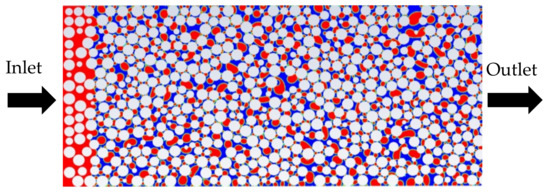
Figure 1.
The geometry of the computational domain (50% water saturation).
At the initial moment, the pore space is filled with a mixture of water and oil at different values of water saturation. Water saturation Sw in this case is the ratio of the volume of water to the total volume of the void space. In the computations, the initial water saturation varied widely from 10 to 90%. To form the initial distribution of water and oil, when initializing the computation, the required value of the water phase fraction was set, further, the computation was carried out with a zero inlet velocity until the oil pressure and volume in the computational domain were established. The initial distribution of water and oil in the computational domain obtained in this way was used to calculate oil displacement by water and nanosuspensions. The initial distribution of water (red) and oil for several levels of initial water saturation is shown in Figure 2. Next, a nanofluid with a given concentration, material, and size of nanoparticles was supplied to the inlet of the computation domain at a given flow rate. The physical properties of nanofluids (density, viscosity, interfacial tension, and wetting angle) were determined from experimental data published in our recent papers [20,21]. Displacement fluid velocity was set at the inlet to the computational domain. The no-slip condition was set at the walls of the computational domain. Neumann conditions were set at the outlet from the computational domain. During the simulation, the amount of oil, displaced by the nanofluid, i.e., ORF, and the pressure drop required for pumping of nanofluid were determined.
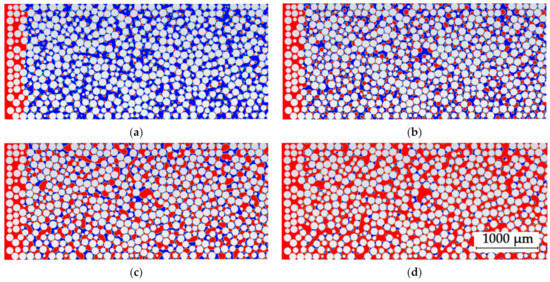
Figure 2.
Initial distribution of water and oil in the computational domain: (a) Sw = 20%; (b) Sw = 40%; (c) Sw = 60%; (d) Sw = 80%.
In the beginning, the effect of the computational grid detailing on the simulation accuracy was studied. Examples of the computational grids used in the computations are shown in Figure 3. For this, a basic computation option with an initial water saturation of 50% was considered, and computations of the ORF and the pressure drop during displacement by water were carried out. The results of the test computations, presented in Table 1, show that an increase in the grid detailing was leading to convergence of the results. Thus, a grid consisting of 786,000 nodes was selected for further computations (Figure 3b).
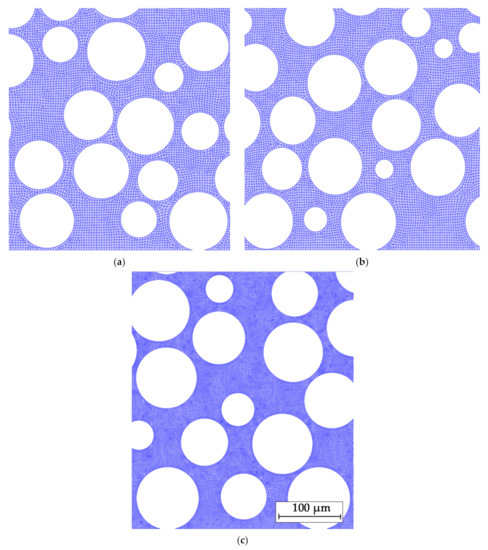
Figure 3.
Computational grids: (a) 320,000 cells; (b) 786,000 cells; (c) 1,428,000 cells.

Table 1.
The results of test computations.
3. Simulation Results
3.1. Investigation of the Nanosuspension Concentration Effect on ORF for Different Initial Water Saturation of a Porous Medium
A numerical study of the oil displacement from a porous medium at different water saturation using water and SiO2 nanosuspensions with different weight concentrations of particles was carried out. In computations, the weight concentration of SiO2 particles varied in the range from 0.125 to 1%. The average size of nanoparticles in this study was equal to 5 nm. The water saturation values Sw of the porous medium in the computations ranged from 10 to 90%. A fixed value of the displacement agent velocity of 1 × 10−4 m/s was set at the inlet to the computational domain, which corresponded to the capillary number equal to 5 × 10−6. The dynamic viscosity coefficient of oil was equal to 7.8 sP. The oil density in the computations was 893 kg/m3.
Figure 4 shows the oil recovery process dynamics when displacing by nanofluid with a concentration of 1 wt% with initial water saturation equal to 50%. The water phase is shown in red. The nanoparticle concentration within the aqueous phase during displacement is shown in Figure 4a. As can be seen, the presence of initial water saturation in the pore space significantly affects the concentration of particles in the displacing nanosuspension. For the considered case with a water saturation of 50%, the concentration at the displacement front reduced from 1 to 0.3 wt%.
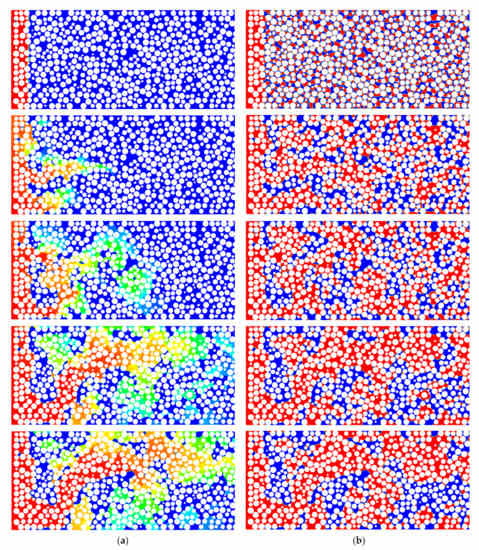
Figure 4.
The concentration of nanoparticles (a) and oil distribution (b) in the process of displacement by nanofluid, φ = 1 wt% and Sw = 50%.
In the course of the computations, the dependences of the oil recovery factor on time were obtained for different water saturation values during oil displacement by water and nanosuspension with a concentration of SiO2 particles of 1%. Figure 5 shows typical dependencies of the oil recovery factor on time for water saturation values equal to 30, 50, and 70%. As can be seen from the graphs presented, the ORF when using nanosuspension was higher than that for water. The shape of the curves for nanosuspension was different than that for water. As can be seen from the graph shown in Figure 5b, the process of displacement using nanofluid proceeded stepwise over time. This shape of the curves was explained by a decrease in the concentration of particles in the displacing nanosuspension due to dilution with water. A change in concentration led to a change in the wetting angle at the nanosuspension/oil/rock interface and the surface tension coefficient for nanosuspension and oil. With an increase in water saturation, the ORF decreased when displacing both by water and nanosuspension.
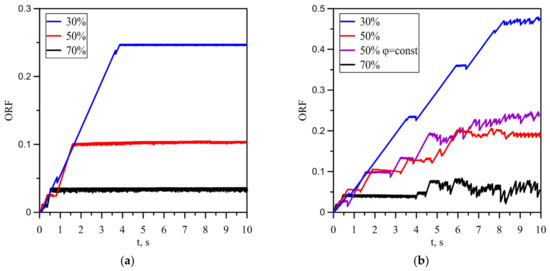
Figure 5.
Dependence of the ORF on time during displacement by water (a) and 1 wt% SiO2 (b) for different initial water saturations.
To evaluate the effect of dilution of the nanoparticle concentration in the nanosuspension on the ORF at a water saturation value of 50%, the computation was performed for a case of a constant concentration of particles in the nanosuspension. The dependence of the ORF at a constant particle concentration is shown in Figure 5b. From the presented graph, it can be seen that the ORF at a constant concentration of particles increased faster with time than that at the dilution with water. The final value of the ORF in the computation with a constant concentration of particles in the nanosuspension was 5% higher than that for a case of decreasing concentration due to dilution with water.
Figure 6 presents the initial (upper picture) and final distribution of oil (red) and displacing fluid (blue) at different water saturations of the porous medium. Water is shown on the left, and the SiO2 nanosuspension with a nanoparticle weight concentration of 1% is shown on the right. The volumetric phase distribution can be considered as steady-state, as it did not change over time during additional pumping of the nanofluid. As can be seen from Figure 7, displacement by water and by nanosuspension occurred differently at different water saturation. When oil was displaced from the computational domain by water, it passed through the computational domain in the form of thin jets, at that, a large volume of oil remained not washed from the porous medium. With an increase in water saturation, the amount of oil displaced decreased, and the distribution of oil in the computational area almost did not change. Unlike water, when displacing by nanosuspension, oil was displaced from the porous medium by a wider front at low water saturation of the medium up to 70%. With a water saturation of more than 70%, small oil droplets were washed off the surface and merged into large drops in the pore space.
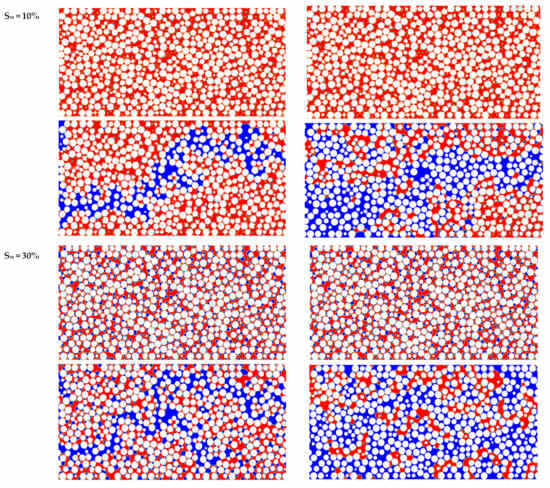
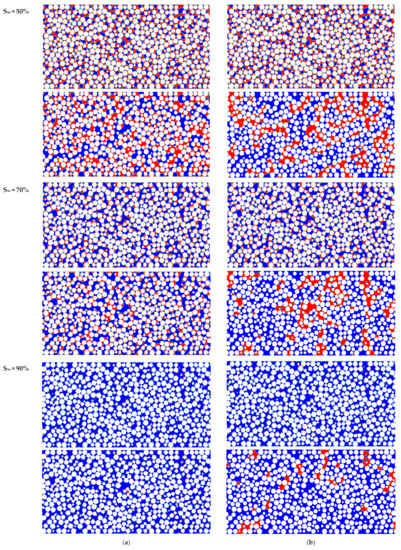
Figure 6.
Distribution of oil (red) and displacing fluid (blue) at different water saturation of the porous medium. Displacement by water (a); nanosuspension (b).
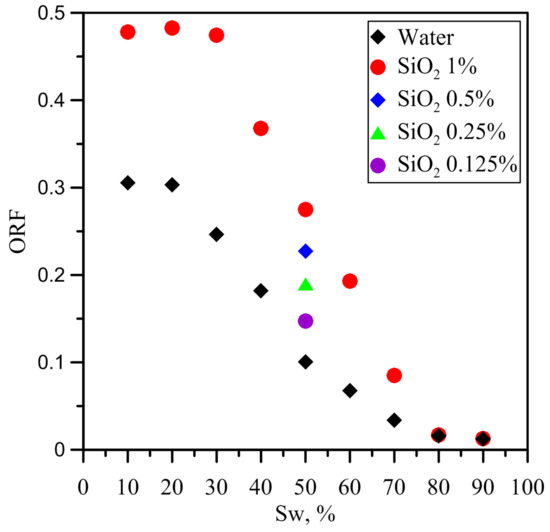
Figure 7.
Dependence of the ORF on the water saturation of a porous medium using water and SiO2 nanosuspension.
Conducted computations resulted in obtaining quantitative characteristics in the form of the dependences of the ORF on the water saturation of the porous medium for water and the SiO2 nanosuspension. Figure 7 shows a graph of the ORF depending on the water saturation of the porous medium for water and the SiO2 nanosuspension with a weight concentration of nanoparticles in the suspension equal to 1%. With an increase in water saturation, the ORF for both water and nanosuspension decreased monotonically. The graph shows that using the nanosuspension made it possible to enhance the ORF for low water saturation of a porous medium by 1.5 times compared to that for water. With an increase in the water saturation, the ORF, when using the nanosuspension, decreased to the values corresponding to water, however, exceeding the ORF values for water by 1.93 times at a water saturation equal to 30% and by 2.85 times at a water saturation equal to 60%.
For water saturation equal to 50%, the effect of the nanoparticle concentration on the ORF was studied within the range from 0.125 to 1%. It was shown that with a decrease in the nanoparticle concentration, the ORF, corresponding to displacement using the nanosuspension, decreased to that corresponding to displacement with water. Thus, for a suspension with a weight concentration of 1%, the ORF was 2.7 times greater than that of water; for a suspension with a weight concentration of 0.25%, the ORF was 1.88 times higher, and for a weight concentration of 0.125%, the ORF was 1.46 times higher than for water.
Figure 8 presents the constructed dependence of the ratio of the ORF for the nanosuspension to that for water on the initial water saturation. As can be seen, there was a maximum of relative ORF corresponding to the water saturation of 60%. Thus, it was revealed that the relative ORF when oil was displaced by the nanosuspension increased at the beginning, reaching a maximum at a certain water saturation, and then sharply decreased, making the use of nanosuspension at a very high initial water saturation impractical due to dilution of the suspension.
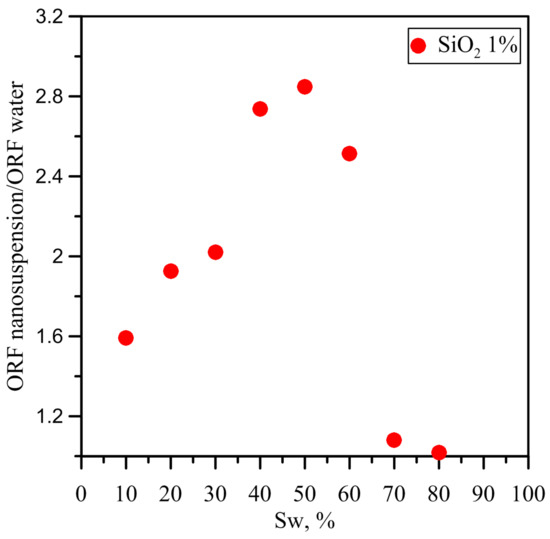
Figure 8.
Dependence of relative ORF on water saturation for different particle concentrations.
Figure 9 shows the dependence of the pressure drop in the computational domain during displacement by water and the 1 wt% SiO2 nanosuspension with a particle size of 5 nm for two water saturation values of 0 and 50%. When oil was displaced at zero initial water saturation, the pressure drop for the nanosuspension was lower than that for water. When oil was displaced at a water saturation of 50%, the pressure drop for the nanosuspension turned out to be higher than the pressure drop for the case of displacement of the oil with initial water saturation by water.
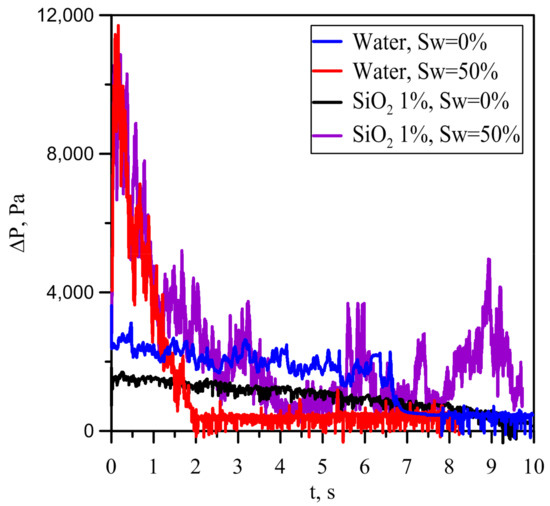
Figure 9.
The pressure drop depending on time for water and nanosuspension with a weight concentration of 1% at water saturations of 0 and 50%.
3.2. Investigation of the Effect of Particle Sizes on Enhancing ORF for Different Water Saturation
We also carried out a numerical study of the effect of particle sizes in the nanosuspension on the ORF using water and a water-based SiO2 nanosuspension with a weight concentration of 0.5% for various values of water saturation of a porous medium. The water saturation Sw of the porous medium in the computations ranged from 0 to 80%. The nanoparticle sizes in the computations were equal to 5, 18, 22, and 50 nm.
A displacement fluid velocity of 1 × 10−3 m/s was set at the inlet to the computational domain. The ORC was equal to 7.8 sP. In the model, experimentally determined values of the surface tension coefficient and the wetting angle, as well as the dynamic viscosity coefficient, were used for each nanosuspension. Experimental data are given in our recent work [20].
Figure 10 shows the calculated distribution of oil (red) and displacing fluid (blue) at different particle sizes in the nanosuspension for different values of water saturation, after pumping 10 pore volumes of displacing fluid. It was seen that using nanosuspensions as a displacing agent significantly affected the displacement of oil from a porous medium for different values of water saturation. This was most noticeable when pure oil was displaced from a porous medium. At that, the nanosuspension with a particle size of 5 nm had the greatest effect on oil displacement compared to displacement with water. When using a nanosuspension, oil was displaced from a porous medium by a wide front, unlike water, which left significant areas filled with oil. As the particle size increased, the displacement efficiency decreased, the areas filled with oil increased, but the flow covered a larger area compared to that with water. With an increase in water saturation, using nanosuspensions with different particle sizes promoted the unification of small oil droplets in a porous medium by changing the wetting angle at the nanosuspension/oil/rock interface, as well as changing the surface tension coefficient.
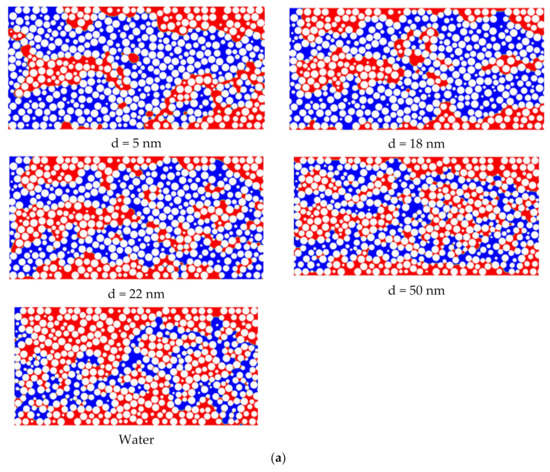
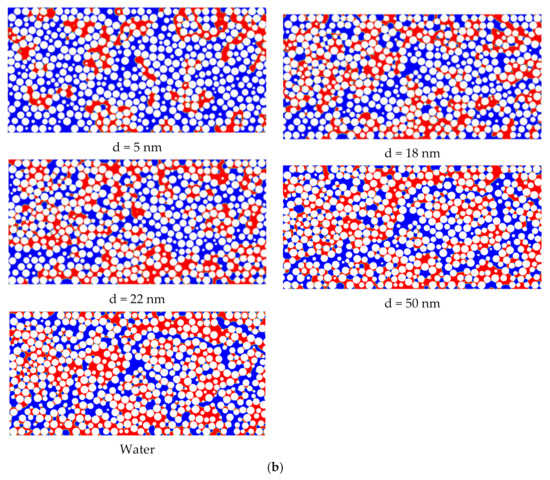
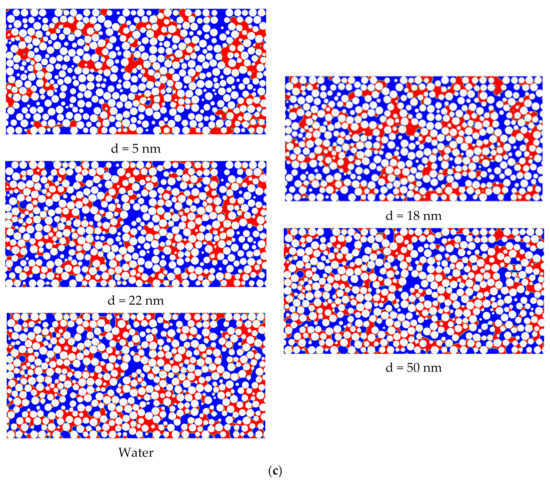
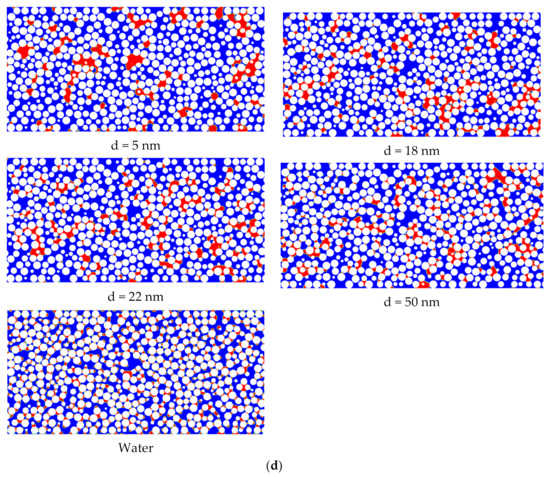
Figure 10.
Distribution of oil (blue) and displacing fluid (red) at different particle sizes in the nanosuspension at different water saturation of the porous medium. Water saturation: 0% (a); 30% (b); 50% (c); 80% (d).
In the course of computations, the dependences of the ORF on the particle sizes in the SiO2 nanosuspension were obtained as quantitative characteristics for different water saturation of the porous medium. In addition, the dependences of the ORF on the water saturation of the porous medium at different particle sizes in the SiO2 nanosuspension were determined. Corresponding graphs are shown in Figure 11.
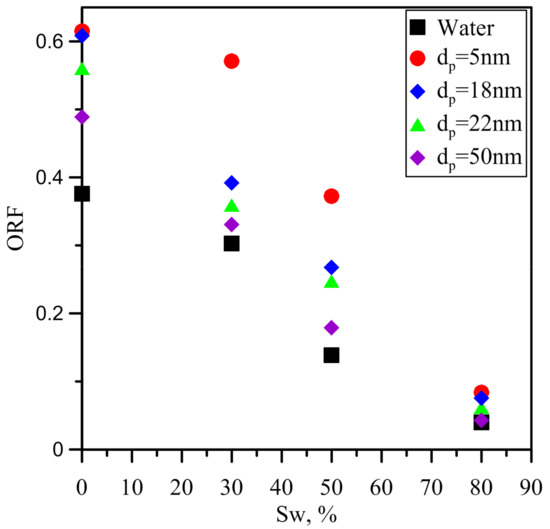
Figure 11.
Dependences of ORF on particle sizes in SiO2 nanosuspension at different water saturation.
It is seen that the ORF increased with a decrease in the particle size in the suspension for different water saturation values (Figure 11). A decrease in the particle size in nanosuspensions led to an increase in the wetting angle at the nanosuspension/oil/rock interface. The ORF value increased significantly at water saturation lower than 60%. With a further increase in water saturation, the growth of the ORF when using nanosuspensions decreased sharply. In this regard, it is advisable to use nanosuspensions with a minimum size of nanoparticles to increase oil recovery at any level of initial water saturation.
4. Conclusions
Oil displacement from a porous medium using nanosuspensions was numerically studied in a wide range of initial water saturation values. A mathematical model of nanoparticle transfer and diffusion within the aqueous phase during immiscible displacement of oil by nanosuspension from a porous medium was developed to conduct numerical simulations. Using this technique, the process of oil displacement from a porous medium at different initial water saturation using water and SiO2 nanosuspensions was investigated numerically for the first time. When using a nanosuspension, oil was displaced from the porous medium by a wide front, unlike water, which left significant areas filled with oil. The computations showed that using the nanosuspension allowed enhancing the ORF at different water saturation. It was shown that the relative ORF (reduced to the ORF for water) when displacing oil by the nanosuspension first increased, reaching a maximum at a certain value of water saturation, and then sharply decreased, making the use of nanosuspension at a very high initial water saturation impractical. At high water saturation values, significant loss of nanoparticles from the displacing nanosuspension were observed due to dilution. The study of the nanoparticle size showed that the ORF enhanced with a decrease in the particle size in the nanosuspension for all initial water saturation values. A decrease in the particle size in nanosuspensions led to an increase in the wetting angle at the nanosuspension/oil/rock interface. In this regard, it is advisable to use nanosuspensions with a minimum size of nanoparticles to increase oil recovery at any level of initial water saturation.
Author Contributions
D.G.: conceptualization, investigation, writing—review and editing. A.M.: conceptualization, writing—review and editing, project administration, funding acquisition. V.R.: writing—review and editing, supervision. S.I.: investigation, writing—review and editing. V.Z.: data curation, methodology, visualization. All authors have read and agreed to the published version of the manuscript.
Funding
The research was carried out with the financial support of the Russian Science Foundation in the framework of project (17-79-20218-P).
Institutional Review Board Statement
Not applicable.
Informed Consent Statement
Not applicable.
Acknowledgments
We are grateful to the Krasnoyarsk Regional Shared Research Center (Krasnoyarsk Scientific Center, Siberian Branch, Russian Academy of Sciences) and Shared Research Center of Siberian Federal University for taking characterization of nanoparticles.
Conflicts of Interest
The authors declared no potential conflicts of interests concerning the research, authorship, and publication of this article.
References
- Mohammed, M.; Babadagli, T. Wettability alteration: A comprehensive review of materials/methods and testing the selected ones on heavy-oil containing oil-wet systems. Adv. Colloid Interface Sci. 2015, 220, 54–77. [Google Scholar] [CrossRef] [PubMed]
- Pavlova, P.L.; Minakov, A.V.; Platonov, D.V.; Zhigarev, V.A.; Guzei, D.V. Supercritical Fluid Application in the Oil and Gas Industry: A Comprehensive Review. Sustainability 2022, 14, 698. [Google Scholar] [CrossRef]
- Jia, B.; Chen, Z.; Xian, C. Investigations of CO2 storage capacity and flow behavior in shale formation. J. Petrol. Sci. Eng. 2022, 208, 109659. [Google Scholar] [CrossRef]
- Liu, D.; Zhang, X.; Tian, F.; Liu, X.; Yuan, J.; Huang, B. Review on nanoparticle-surfactant nanofluids: Formula fabrication and applications in enhanced oil recovery. J. Dispers. Sci. Technol. 2020, 1–15. [Google Scholar] [CrossRef]
- Sun, Y.; Yang, D.; Shi, L.; Wu, H.; Cao, Y.; He, Y.; Xie, T. Properties of Nano-fluids and Their Applications in Enhanced Oil Recovery: A Comprehensive Review. Energy Fuels 2020, 34, 1202–1218. [Google Scholar] [CrossRef]
- Kumar, N.; Verma, A.; Mandal, A. Formation, characteristics and oil industry applications of nanoemulsions: A review. J. Petrol. Sci. Eng. 2021, 206, 109042. [Google Scholar] [CrossRef]
- Foroozesh, J.; Kumar, S. Nanoparticles behaviors in porous media: Application to enhanced oil recovery. J. Mol. Liq. 2020, 316, 113876. [Google Scholar] [CrossRef]
- Chandio, T.A.; Manan, M.A.; Memon, K.R.; Abbas, G.; Abbasi, G.R. Enhanced Oil Recovery by Hydrophilic Silica Nanofluid: Experimental Evaluation of the Impact of Parameters and Mechanisms on Recovery Potential. Energies 2021, 14, 5767. [Google Scholar] [CrossRef]
- Zallaghi, M.; Kharrat, R.; Hashemi, A. Improving the microscopic sweep efficiency of water flooding using silica nanoparticles. J. Petrol. Explor. Prod. Technol. 2018, 8, 259–269. [Google Scholar] [CrossRef]
- Xu, K.; Agrawal, D.; Darugar, Q. Hydrophilic Nanoparticle-Based Enhanced Oil Recovery: Microfluidic Investigations on Mechanisms. Energy Fuels 2018, 32, 11243–11252. [Google Scholar] [CrossRef]
- Youssif, M.I.; El-Maghraby, R.M.; Saleh, S.M.; Elgibaly, A. Silica nanofluid flooding for enhanced oil recovery in sandstone rocks. Egyp. J. Pet. 2018, 27, 105–110. [Google Scholar] [CrossRef]
- Ju, B.; Fan, T.; Ma, M. Enhanced oil recovery by flooding with hydrophilic nanoparticle. China Particuol. 2006, 4, 41–46. [Google Scholar] [CrossRef]
- Ju, B.; Fan, T. Experimental study and mathematical model of nanoparticle transport in porous media. Powder Technol. 2009, 192, 195–202. [Google Scholar] [CrossRef]
- Feng, Y.; Cao, L.; Shi, E. A Numerical Investigation of Enhanced Oil Recovery Using Hydrophilic Nanofluids. J. Sustain. Energy Eng. 2017, 5, 67–97. [Google Scholar] [CrossRef]
- Sepehri, M.; Moradi, B.; Emamzadeh, A.; Mohammadi, A.H. Experimental study and numerical modeling for enhancing oil recovery from carbonate reservoirs by nanoparticle flooding. Oil Gas Sci. Technol. Rev. IFP Energ. Nouv. 2019, 74, 5. [Google Scholar] [CrossRef]
- Yu, J.; Berlin, J.M.; Lu, W.; Zhang, L.; Kan, A.T.; Zhang, P.; Walsh, E.E.; Work, S.N.; Chen, W.; Tour, J.M.; et al. Transport Study of Nanoparticles for Oilfield Application. In Proceedings of the SPE International Conference on Oilfield Scale, Aberdeen, UK, 26–27 May 2010. [Google Scholar]
- Gharibshahi, R.; Jafari, A.; Ahmadi, H. CFD investigation of enhanced extra-heavy oil recovery using metallic nanoparticles/steam injection in a micromodel with random pore distribution. J. Pet. Sci. Eng. 2019, 174, 374–383. [Google Scholar] [CrossRef]
- Hirt, C.W.; Nichols, B.D. Volume of fluid (VOF) method for the dynamics of free boundaries. J. Comput. Phys. 1981, 39, 201–225. [Google Scholar] [CrossRef]
- Brackbill, J.U.; Kothe, D.B.; Zemach, C. A continuum method for modeling surface tension. J. Comput. Phys. 1992, 100, 335–354. [Google Scholar] [CrossRef]
- Minakov, A.V.; Pryazhnikov, M.I.; Suleymana, Y.N.; Meshkova, V.D.; Guzei, D.V. Experimental study of nanoparticle size and material effect on the oil wettability characteristics of various rock types. J. Mol. Liq. 2021, 327, 114906. [Google Scholar] [CrossRef]
- Minakov, A.V.; Guzei, D.V.; Pryazhnikov, M.I.; Filimonov, S.A.; Voronenkova, Y.O. 3D pore-scale modeling of nanofluids-enhanced oil recovery. Pet. Explor. Dev. 2021, 48, 956–967. [Google Scholar] [CrossRef]
- Rudyak, V.Y.; Belkin, A.A.; Tomilina, E.A.; Egorov, V.V. Nanoparticle friction force and effective viscosity of nanofluids. Defect Diffus. Forum 2008, 273–276, 566–571. [Google Scholar]
- Rudyak, V.Y.; Belkin, A.A.; Tomilina, E.A. Force acting on nanoparticle in fluid. Tech. Phys. Let. 2008, 34, 76–78. [Google Scholar] [CrossRef]
Publisher’s Note: MDPI stays neutral with regard to jurisdictional claims in published maps and institutional affiliations. |
© 2022 by the authors. Licensee MDPI, Basel, Switzerland. This article is an open access article distributed under the terms and conditions of the Creative Commons Attribution (CC BY) license (https://creativecommons.org/licenses/by/4.0/).